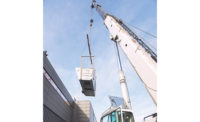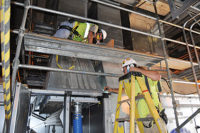
|
| In order to keep rooftop units running like new, contractors and technicians agree that consistent preventive maintenance is a must. (Photo courtesy of Dan Sweet, Columbia Helicopters Inc.) |
The NEWS interviewed several HVAC technicians and contractors and asked them to share the top five issues they encounter when servicing rooftop units (RTUs) and air handlers as well as how they recommend resolving those issues and preventing them from occurring again. Here are their responses.
Top 5 Issues
The five most common problems identified by technicians or contractors included:
• Dirty coils — Dirty coils can affect the unit’s performance and contribute to poor IAQ. “[This is] pretty much visual, so a tech can readily see the problem,” said Bob Keingstein, president, HVAC and plumbing division, Boss Facility Services Inc., Ronkonkoma, New York.
• Worn or loose fan belts — “We run into lots of worn contactors, sheaves, belts, failed bearings, condenser fan motors, etc.,” said Ken Misiewicz, president and CEO of Pleune Service, Grand Rapids, Michigan. Technicians should monitor and replace these belts as needed during routine maintenance.
• Dirty/clogged air filters — “We are coming into the cottonwood season soon, and that will become our No. 1 problem,” Misiewicz said. Clogged filters can make the motor work harder to draw air into the unit, increasing the chance of motor burnout.
• Fan motor problems — “Sometimes, even though the equipment is being taken care of properly, there can be repeat failures of the same motor or card, etc.,” said Jim Crews, service/sales, project manager, Environmental Conditioning Systems, Mentor, Ohio. “Try to find manufacturer’s support. If that does not resolve the issue, rely on tech support from regional manufacturer’s reps of the failing components.”
• Worn contactors — Half of the contractors and technicians who were interviewed listed worn contactors as one of the most common issues they encounter. “On my old equipment, it has become commonplace to change contactors,” said Tom Dutton, operations engineer at Latisys, a large data center in Chicago. “I go through at least 100 per year.”
Preventing Problems
While normal wear and tear is to be expected on rooftop units, major problems can be prevented with routine, thorough maintenance.
“We make sure the client has regular maintenance, as most of these issues can be prevented with a good maintenance program,” Keingstein said. “But, due to budget constraints over the past few years, clients are eliminating one maintenance visit per year and going from four to three visits. Some have completely cancelled the maintenance; however, they also have seen the consequences of cancellation.”
Crews recommends that technicians keep their machines clean and lubricated. “All techs have a flow chart for troubleshooting,” he added. “Many of these flow charts are brand-specific and are based on a working history with the equipment. I coach my guys to start at the beginning and keep it simple until all those items are ruled out. Many electronically controlled units have codes and readouts that, without the installation and operation manual (IOM) or troubleshooting guide, we would be lost.”
Mike Knight, technician, Westside Mechanical Inc., Naperville, Illinois, said resolving these common issues “relies upon communication between service techs, customers, and account managers.” He also agreed that “future resolution of the issues strictly relies on the customers’ willingness to participate in a well-structured maintenance program with the ability to accept recommended repairs as needed to keep the RTUs in working condition.”
Nearly all of Misiewicz’s customers are on a preventative maintenance program, he said, which is usually performed quarterly. “By going through the proper tasking, our technicians are often able to identify potential problems before they cause down time,” he said.
“Resolving and keeping the problems from recurring falls under the category of a good preventive maintenance program,” agreed Tom Kelly, technician, Westside Mechanical.
When it comes to cleaning coils, one contractor has found a way to turn a profit doing it in an environmentally friendly manner.
Alan Wozniak, president and CEO of Pure Air Control Services Inc., Clearwater, Florida, said he’s had great success with the company’s environmentally friendly preventive maintenance plans, which focus on improving the performance of the rooftop unit while optimizing IAQ.
“We look at the air handler environmentally and what we can do to make it environmentally clean while saving energy,” he said. “The benefits are astronomical.”
Due Diligence
Several technicians and contractors stressed the importance of doing one’s due diligence on the job site. “Techs need to examine the entire unit for future problems,” said Dave Rayas, technician, Westside Mechanical. “Be proactive, not reactive.”
“Some workers go too fast in trying to complete the call and move on to the next client,” Keingstein said. “They also may see the obvious, such as a tripped safety control, and just reset it instead of finding the reason for the trip and correcting the root cause of
the problem.”
Misiewicz said many of these mistakes are made by less experienced technicians who simply don’t yet have the job experience necessary to recognize potential issues before they become real problems.
“On the technical side, ‘common’ mistakes are only common to the less experienced techs — high-level technicians know when to check an evaporator for buildup, when to cycle an economizer, and when to do a deep dive versus a cursory examination, because they have the experience to know the problem areas and take preemptive action,” Misiewicz said. “Less-experienced technicians don’t have the feel for the equipment and can miss the more subtle cues to a potential problem. Unfortunately, getting bit is part of gaining experience.”
The Value of Training
Continuing education is high on the list of priorities for many of the technicians and contractors surveyed. Training helps everyone in the company — technicians, office staff, sales, and management alike — hone their skills and stay up to date on the latest industry technology and information.
“We believe strongly in technical training as well as customer service training,” Keingstein said. “We find that fixing the customer first is half the battle — fixing the equipment is the other half. Proper communication is key.”
Misiewicz said continuing education is a big part of his company’s effort to attract qualified technicians. “We use a combination of lab training, hands-on field work, supplier/vendor training, and factory training of all shapes and sizes,” he said. “Equipment and controls are continuing to evolve quickly, and staying on top of everything takes a lot of effort.”
“Without this investment, our techs could not be the best in our market,” agreed Crews. “And we only want to run with the best.”
Publication date: 6/16/2014
Want more HVAC industry news and information? Join The NEWS on Facebook, Twitter, and LinkedIn today!










